NEWSLETTER 27
August–September 2016
A FORGIVING HEART CARESSES
Pope Francis at the Basilica of Saint Mary of the Angels, Porziuncola – Assisi
ON THE OCCASION OF THE EIGHTH CENTENARY OF THE PARDON OF ASSISI
Thursday, 4 August 2016
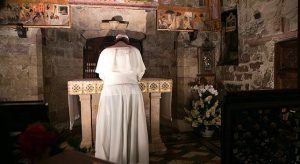 Today, I would like before all else to recall the words that, according to an ancient tradition, Saint Francis spoke in this very place, in the presence of all the townsfolk and bishops: “I want to send you all to heaven!” What finer thing could the Poor Man of Assisi ask for, if not the gift of salvation, eternal life and unending joy, that Jesus won for us by his death and resurrection?
Today, I would like before all else to recall the words that, according to an ancient tradition, Saint Francis spoke in this very place, in the presence of all the townsfolk and bishops: “I want to send you all to heaven!” What finer thing could the Poor Man of Assisi ask for, if not the gift of salvation, eternal life and unending joy, that Jesus won for us by his death and resurrection?
Besides, what is heaven if not the mystery of love that eternally unites us to God, to contemplate him forever? The Church has always professed this by expressing her belief in the communion of saints. We are never alone in living the faith; we do so in the company of all the saints and holy ones, including our loved ones who practised the faith with joyful simplicity and bore witness to it by their lives. There is a bond, unseen but not for that reason any less real, which makes us, by baptism, “one body” moved by “one Spirit” (cf. Eph 4:4). When Saint Francis asked Pope Honorius III to grant an indulgence to all who visited the Porziuncola, he was perhaps thinking of Jesus’ words to the disciples: “In my Father’s house are many rooms; if it were not so, would I have told you that I go to prepare a place for you? And when I go and prepare a place for you, I will come again and will take you to myself, that where I am you may be also” (Jn 14:2-3).
Forgiveness – pardon – is surely our direct route to that place in heaven. How hard it is to pardon! How much effort it takes for us to forgive others! Let us think about this. Here at the Porziuncola everything speaks to us of pardon! What a great gift the Lord has given us in teaching us to forgive – or at least to try to forgive – and in this way to touch the Father’s mercy! We have heard the parable in which Jesus teaches us to forgive (cf. Mt 18:21-35). Why should we forgive someone who has offended us? Because we were forgiven first, and of infinitely more. There is no one here who has not been forgiven. Let each of us reflect on this… Let us reflect in silence on the wrong we have done and how the Lord has forgiven us. The parable tells us exactly this: just as God has forgiven us, so we too should forgive those who do us harm. This is the caress of forgiveness. A forgiving heart caresses. It is far removed from the attitude of: “You’ll pay for this!” Forgiveness is something other. So it is with the prayer that Jesus taught us, the Our Father, in which we say: “Forgive us our debts, as we also have forgiven our debtors” (Mt 6:12). The debts are our sins in the sight of God, and our debtors are those whom we, for our part, must forgive.
His is a pardon that is full and complete, one that assures us that, even if we fall back into the same sins, he is merciful and never ceases to love us. Like the master in the parable, God feels compassion, a mixture of pity and love; that is how the Gospel describes God’s mercy towards us. Our Father is moved to compassion whenever we repent, and he sends us home with hearts calm and at peace. He tells us that all is remitted and forgiven. God’s forgiveness knows no limits; it is greater than anything we can imagine and it come to all who know in their hearts that they have done wrong and desire to return to him. God looks at the heart that seeks forgiveness.
The problem, unfortunately, comes whenever we have to deal with a brother or sister who has even slightly offended us. The reaction described in the parable describes it perfectly: “He seized him by the throat and said, ‘Pay what you owe!’” (Mt 18:28). Here we encounter all the drama of our human relationships. When we are indebted to others, we expect mercy; but others are indebted to us, we demand justice! All of us do this. It is a reaction unworthy of Christ’s disciples, nor is it the sign of a Christian style of life. Jesus teaches us to forgive and to do so limitlessly: “I do not say to you seven times, but seventy times seven” (v. 22). What he offers us is the Father’s love, not our own claims to justice. To trust in the latter alone would not be the sign that we are Christ’s disciples, who have obtained mercy at the foot of the cross solely by virtue of the love of the Son of God. Let us not forget, then, the harsh saying at the end of the parable: “So also my heavenly Father will do to every one of you, if you do not forgive your brother from your heart” (v. 35).
The world needs forgiveness; too many people are caught up in resentment and harbour hatred, because they are incapable of forgiving. They ruin their own lives and the lives of those around them rather than finding the joy of serenity and peace. Let us ask Saint Francis to intercede for us, so that we may always be humble signs of forgiveness and channels of mercy.
ROME – cf. Promotional video of the Camillianum
ROME – JUBILEE OF VOLUNTEERS AND WORKERS OF MERCY AT THE CHURCH OF ST. MARY MAGDALENE (2-4 September 2016)
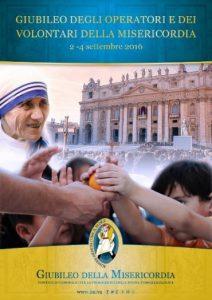 The Pontifical Council for the New Evangelisation – to which is entrusted the organisation of the events for the Extraordinary Jubilee of Mercy – asked for the availability of our fine Church of St. Mary Magdalene to organise a part of the great jubilee event that will culminate in the canonisation of Mother Teresa of Calcutta (an event envisaged for Sunday, 4 September 2016).
The Pontifical Council for the New Evangelisation – to which is entrusted the organisation of the events for the Extraordinary Jubilee of Mercy – asked for the availability of our fine Church of St. Mary Magdalene to organise a part of the great jubilee event that will culminate in the canonisation of Mother Teresa of Calcutta (an event envisaged for Sunday, 4 September 2016).
On 2-3 September 2016 – from 14.00 to 21.00 (non-stop) – our church has been entrusted with the catechesis of Mercy, for events involving meditation and prayer, and for the celebration of the sacrament of reconciliation, specifically in the context of the Jubilee of Volunteers and Workers of Merc
Cf. The article of Fr. Anthoni Jeorge Kunnel on his personal experience of service with Mother Teresa of Calcutta. ITA/ENG
INDIA – Appeal of Fr. Baby Ellickal – Provincial Superior – after the flooding in Bihar
A massive flood has occurred around the banks of the River Ganga. As per the official report, 2.9 million people are affected and 69 reported dead as on 4th August. Fed by heavy rains in the Terai region of Nepal, Ganga river at Kahalgaon in Bhagalpur district remained above the danger mark. River Ghaghra-Darauli, River Gangpur-Siswan , Adhwara group of rivers was above danger level in Sivan, Darbhanga, Bagmati-Benibad in Muzaffarpur district and Mahananda in Purnea. In Bihar, the 12 flood affected districts of the state are Purnea, Kisanganj, Araria, Darbhanga, Madhepura, Bhagalpur, Katihar, Saharsa, Supual, Gopalganj, Muzaffarpur and East Champaran. In which, 68 blocks and 580 panchayats are affected by floods.
Hundreds have lost their lives, thousands have lost their houses and again thousands are missing. It takes a long time to build their life back to normalcy. We request all of our dear friends, benefactors, well-wishers and healthcare volunteers to support this cause with their prayers, presence or other means of contributions. CTF will be organizing the medical camps along with CARITAS India and will begin the relief medical camps on 10th August. We shall ensure that whatever financial aid you may provide through the CTF-India reaches the deserving.
Thanking you in anticipation.
Yours sincerely
Fr. Baby Ellickal – Provincial – St. Camillus Provincialate
THE CAMILLIANS IN GEORGIA AND WAITING FOR POPE FRANCIS: ‘GO TO THE FRINGES!’
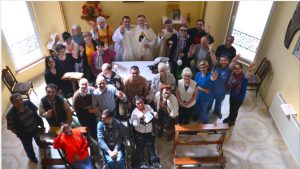 The Vatican press office has published the programme of the apostolic journey of Pope Francis in Georgia and Azerbaijan (30 September-2 October 2016). On 1 October – the feast day of Saint Therese of Lisieux, the patron saint of missions – the Holy Father will celebrate a meeting with those helped by, and those working for, the works of charity of the Church. This meeting will take place in front of the care centre of the Camillians.
The Vatican press office has published the programme of the apostolic journey of Pope Francis in Georgia and Azerbaijan (30 September-2 October 2016). On 1 October – the feast day of Saint Therese of Lisieux, the patron saint of missions – the Holy Father will celebrate a meeting with those helped by, and those working for, the works of charity of the Church. This meeting will take place in front of the care centre of the Camillians.
Georgia is a very beautiful country and yet it is also a very poor one. Since independence from the Soviet Union, which took place in the 1990s, the country has encountered difficulties in dealing with economic and commercial competition with other States.
Still today the relations between the Russian Federation and Georgia are tense and in the recent past the invasion of Ossezia and Abkasia forced thousands of residents of those regions to abandon their homes. As a result of the intervention of the President of Poland, Lech Kaczynski, and of the European Union, it was possible to contain the crisis. The internal situation of Georgia is also critical and this is because of a welfare system that is not able to meet to the full the needs of the population. The condition of disabled people is still particularly serious.
Disabled people are culturally excluded from the social fabric of the country and are forced to live with limited opportunities for integration, instruction, socialisation, and improvements in their general conditions of life.
The first missionaries arrived in Tbilisi in 1998 in response to an invitation made to them by John Paul II who entrusted them with the running of a polyclinic located in Temka, on the outskirts of the capital Tbilisi.
In 2003, at the side of the polyclinic, a new building was constructed to be a day and rehabilitation centre to meet the real needs of the many families with whom the Camillians had come into contact, in particular through home nursing care for those sick people who because of their grave conditions of health could not leave their homes.
In providing this service, the eyes of the first missionaries were opened to a world of abject poverty and abandonment: the Communist regime had profoundly shaped the mentality and the customs of the people, especially those who were particularly poor and disadvantaged.
The disabled, for example, for cultural reasons, were not to be seen during the years of the regime: they were confined to their homes and had no opportunity to construct and cultivate their own social networks. They were looked after exclusively, and with a great deal of hard work, by their family relatives alone.
The day and rehabilitation centre was the response of the Ministers of the Sick to this unjust state of affairs.
From the very day of its opening, the Camillian missionaries were to be seen going up and down the rickety stairways of run-down apartment blocks in the outskirts of Tbilisi, carrying disabled boys and girls in their arms or on their shoulders because during the years of the regime the lifts that were built in these apartment blocks were designed only for people who were not disabled and wheelchairs, for example, could not get into them.
The aim of the Camillians was to offer disabled people a place where they could talk, develop friendships, maintain or increase their residual capacities, obtain psychological support, and learn to read and write, to use a computer, to do embroidery, to sing and dance…
Today the ‘Lasha’ (in memory its first beneficiary who died of tuberculosis) day and rehabilitation centre has a special agreement with the state and constitutes one of the best social/care poles in Georgia.
The occupational activities that are offered by this centre are music therapy, a pottery laboratory, a carpentry laboratory, a computer laboratory, a writing and reading laboratory, game therapy, and individual and group psychological support.
In addition to the activities engaged in at Tbilisi , we may observe that the Camillians are present in the village of Arali, with the ‘Son of God’ day centre; in the village of Akhaltzikhe, with the ‘Talitha Kum’ day and rehabilitation centre which is run by them together with the Sisters of St. Nino; and in the village of Shavshvebi, with an after-school centre known as ‘Grandmother’s Little Home’.
After Pope’s Francis’ historic journey to Armenia last June, the Church of Tbilisi is now awaiting, and preparing for, the visit of the Supreme Pontiff which is planned for the end of September of this year.
The Bishop of Tbilisi, Msgr. Giuseppe Pasotto, in recent days published the programme of this visit which also includes a visit of the Supreme Pontiff to the representatives of the charitable works of the Church which are spread throughout the national territory of Georgia (Caritas, the women Missionary Sisters of Charity, the Little Daughters of St. Joseph, the John XIII Community Association, the Camillians, etc.).
This meeting will take place in the area of the St. Camillus Mission. This is a great honour for us and will enable us to give Pope Francis the best of presents: a meeting with our disabled boys and girls, our disadvantaged families, and our sick people – the chosen of St. Camillus and our heavenly Father; our lords and masters.
We are certain that the Holy Father will appreciate this meeting and we venture to hope that it will be able to offer to everyone moments of sharing and happiness which will be remembered with joy!
May our fraternal embrace reach you from Georgia!
The Camillian Missionary Religious
The Province of North Italy – TRENTO
THE RELIC OF THE HEART OF SAINT CAMILLUS DE LELLIS IN TRENTO
The Camillian Family of Trento proposed to the Consulta for Pastoral Care in Health of the diocese, on the occasion of the Jubilee of the Sick and Christian Associations dedicated to helping them, a veneration of the relic of the heart of St. Camillus de Lellis, the patron saint of the sick and those who care for them.
The programme is for 24-26 September of this year and will involve the Camillian religious of the Church of the Sacred Heart, the women religious the Daughters of St. Camillus and their clinic, and the diocese of Trento, with celebrations in the Duomo and Camillian activity to provide assistance to psychiatric patients at the Maso S. Pietro of Pergine.
TAIWAN
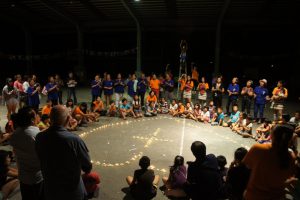 On 29 July of this year, in Hanshi, there came to a close a month of activity organised by university students of the Furen Catholic University who every year offer a month of their time to help students of elementary and secondary schools to advance both in their education and their faith.
On 29 July of this year, in Hanshi, there came to a close a month of activity organised by university students of the Furen Catholic University who every year offer a month of their time to help students of elementary and secondary schools to advance both in their education and their faith.
On 31 July, one of our parishioners of Hanshi received an award from the government in recognition of his constant activity as head of the charitable institution for the whole of the area.
On 3 August, in line with Taiwanese culture, the feast day of the spirits is celebrated. According to tradition, during the seventh lunar month spirits are free to leave hell and people engage in various ceremonies in order to protect themselves against them. The Church has tried to ‘Christianise’ this event, proposing prayers for ancestors and blessing the various parts of our hospital with holy water.
During the month of August the newly ordained Camillian priest, Fr. Henry II Angupa, celebrated a thanksgiving Holy Mass in a number of churches in Taiwan.
Commemoration of Fr. Celestino Rizzi and Sr. Claudia Martinelli sixty-five years after their deaths
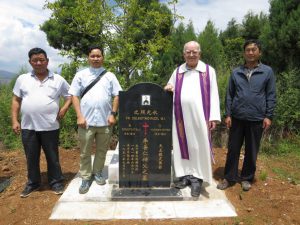 On 30 August 1951, in Yunnan (China), after only three years of work, a Camillian sister who worked as a nurse in the hospital built by the Camillians died of typhus. Two weeks later, and more precisely on 13 September 1951, cared for by his religious brothers, the Superior of the Camillian community, Fr. Celestino Rizzi, died of meningitis. He was only thirty-seven.
On 30 August 1951, in Yunnan (China), after only three years of work, a Camillian sister who worked as a nurse in the hospital built by the Camillians died of typhus. Two weeks later, and more precisely on 13 September 1951, cared for by his religious brothers, the Superior of the Camillian community, Fr. Celestino Rizzi, died of meningitis. He was only thirty-seven.
Sister Claudia Martinelli – a woman Minister of the Sick – and this Camillian religious were buried in the Catholic cemetery. The next year the Communists invaded this territory of China and ploughed over the graves, where in addition to Sr. Claudia and Fr. Celestino, three other fathers of the foreign missions of Paris, three Chinese fathers and two sisters were also buried.
The graves have disappeared but after seventy years the current parish priest, with some of the faithful of his parish, carrying some tools went up on the mountain to have a look at the state of the graves. After some digging, they found the names of the sisters and the fathers but they only found the bones Fr. Celestino. Following our suggestions they rebuilt his grave, whereas for the others they placed just a commemorative tombstone.
On 9 August 2016 Fr. Giuseppe Didoné, the Camillian Delegate of Taiwan, was invited to bless this grave. Fr. Celestino Rizzi was born in Cavizzana on 6 June 1914. In 1947 the second group of Camillian missionaries, made up of six people, left for China. Fr. Celestino was a member of this group.
After studying Chinese in Peking, he was sent to Huitse, a city in Yunnan, where he immediately began to build the St. Camillus Hospital which was inaugurated on 15 August 1948. Inside it there was a small church dedicated to the Sacred Heart. He had in mind building a large church dedicated to the Immaculate Mary but with the arrival of Communism he was not able to complete the project. On 12 September 1949 Fr. Celestino also opened an elementary school. On 8 December of the same year he opened an orphanage, the running of which was later entrusted to the sisters.
Fr. Celestino had promised that he would not leave China, not even with the arrival of Communism: the Lord answered his prayers by calling him to Him but his body remained interred in Chinese soil. After the arrival of Communism, the hospital was requisitioned by the Communists and retained its name of the St. Camillus Hospital for only five years. It was then called the Hospital of the People, even though its directors always showed to all visitors the Catholic origins of that health-care institution. Where the orphanage was previously to be found there is now the parish church. Some elderly Christians, the over eighty-fives, still remember the special style of Fr. Celesino who baptised them and of Br. Davide Giordan who as a nurse attended to their illnesses.
CADIS – The Annual Conference of the Heads of CADIS
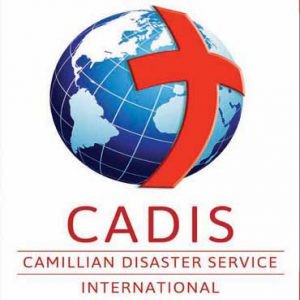 Fr. Aris Miranda, the member of the General Consulta responsible for ministry, has announced the holding of the Annual Conference of the Heads of CADIS (the Camillian Disaster International Service) which will take place on 21-30 November 2016 at the Camillian Centre for Pastoral Work of Bangkok (Thailand). The theme of this international conference will be ‘Building up the Resilience of the most Vulnerable Communities through Innovation, Partnership and the Construction of Networks: Accompanying the First Steps towards 2020’.
Fr. Aris Miranda, the member of the General Consulta responsible for ministry, has announced the holding of the Annual Conference of the Heads of CADIS (the Camillian Disaster International Service) which will take place on 21-30 November 2016 at the Camillian Centre for Pastoral Work of Bangkok (Thailand). The theme of this international conference will be ‘Building up the Resilience of the most Vulnerable Communities through Innovation, Partnership and the Construction of Networks: Accompanying the First Steps towards 2020’.
Cf. INVITATION
EARTHQUAKE IN CENTRAL ITALY
A little more a week has passed since the earthquake which struck the centre of Italy at dawn on 24 August of this year. The funerals of the victims of Amatrice brought to an end the first stage of the emergency and began more complex and involved work whose principal objective is reconstruction. This needs clear timetables.
On Tuesday 30 August the CADIS team coordinated by Father Aris Miranda and made up of Father Sergio Palumbo and Father John Toai began its work of assessing needs in the diocese of Rieti (Amatrice).
We make an appeal to our Provincial Superiors of Italy to make available men and women religious who could be valuable in work involving listening to and accompanying the victims, with stays of varying degrees of length, as well to provide the always needed economic resources.
INTERNATIONAL MEETING OF CAMILLIAN CHAPLAINS
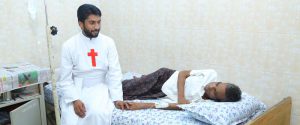 On 4-6 November 2016, at the generalate house of the Brothers of Christian Schools (Lassalians) of Rome, the International Conference of Camillian Chaplains will be held. This meeting will be organised around the theme: ‘Hospital Chaplaincies, at the Heart of Camillian Mission’.
On 4-6 November 2016, at the generalate house of the Brothers of Christian Schools (Lassalians) of Rome, the International Conference of Camillian Chaplains will be held. This meeting will be organised around the theme: ‘Hospital Chaplaincies, at the Heart of Camillian Mission’.
Cf. INVITATION
ROME – THE GENERALATE HOUSE
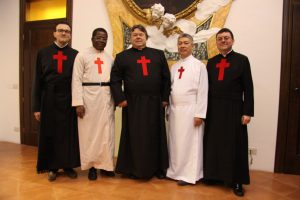 On 5-7 September 2016, at the generalate house in Rome, there took place the fourth meeting of the Central Economic Commission of the Order (Fr. Lorenzo Testa, Fr. Giovanni Contarin, Fr. Mario Kozik, Fr. Giustino Scattolin, Rag. Massimo Iannacchino and Dr. Emilio Servando Villar Pernas), with the presence of the Superior General and Br. José Ignacio Santaolalla, the general financial administrator of the Order, as the coordinator. Thanking them for their generous readiness to help, we wish them fruitful work in increasing ‘vigilance and transparency in addressing economic-financial questions’.
On 5-7 September 2016, at the generalate house in Rome, there took place the fourth meeting of the Central Economic Commission of the Order (Fr. Lorenzo Testa, Fr. Giovanni Contarin, Fr. Mario Kozik, Fr. Giustino Scattolin, Rag. Massimo Iannacchino and Dr. Emilio Servando Villar Pernas), with the presence of the Superior General and Br. José Ignacio Santaolalla, the general financial administrator of the Order, as the coordinator. Thanking them for their generous readiness to help, we wish them fruitful work in increasing ‘vigilance and transparency in addressing economic-financial questions’.
DIARY OF THE SUPERIOR GENERAL AND THE GENERAL CONSULTA
On 10-25 July, Fr. Leocir Pessini and Br. Ignacio Santaolalla were in Brazil to visit the religious of the Camillian communities of the North, North-East and East of the country.
MESSAGE OF THE SUPERIOR GENERAL TO THE COMMUNITIES OF THE PROVINCE OF BRAZIL AT THE END OF THE (PASTORAL AND CANONICAL) FRATERNAL VISIT TO THE CAMILLIAN PROVINCE OF BRAZIL Expression of thanks!
The Superior General, together with Br. José Ignacio Santaolalla, the general financial administrator of the Order, on 15- 18 August 2016 took part in Lima in the general assembly of the Vice-Province of Peru.
Message PORTOGHESE / INGLESE / SPAGNOLO / ITALIANO
On 4-14 September 2016, Fr. Leocir Pessini, together with Fr. Aris Miranda, will visit the religious of the Camillian community of Sydney (Australia).
On 15-26 September 2016, Fr. Leocir Pessini will visit the religious of the Camillian communities of the Province of Sicily and Naples.
THE NEXT MEETING OF THE SUPERIOR GENERAL AND THE MEMBERS OF THE GENERAL CONSULTA WITH THE MAJOR SUPERIORS OF THE ORDER
 The next meeting of the Superior General and the members of the General Consulta with the major Superiors of the Order will be celebrated in Ouagadougou (Burkina Faso) on 9- 16 October 2016 at the Centre National Cardinal Paul Zoungrana (CNCPZ) which is located in the centre of the capital near to the ‘Centre Médical S. Camille’ of Ouagadougou.
The next meeting of the Superior General and the members of the General Consulta with the major Superiors of the Order will be celebrated in Ouagadougou (Burkina Faso) on 9- 16 October 2016 at the Centre National Cardinal Paul Zoungrana (CNCPZ) which is located in the centre of the capital near to the ‘Centre Médical S. Camille’ of Ouagadougou.
This meeting forms a part of the celebrations for the fiftieth anniversary of the arrival of the Camillians in Burkina Faso. The jubilee spirit will also be a context to celebrate together the canonical erection of the new Camillian Province of Burkina Faso (a celebration envisaged for 13 October 2016).
The jubilee celebration (‘thanksgiving’) is envisaged for 16 October 2016, with an invitation to take part being extended to all the Camillian religious who over the last fifty years have made possible the presence of the Camillian charism in Burkina Faso.
The Camillian religious of Burkina Faso have already begun the Jubilee Year of Mercy for the arrival of the first Camillians in the country fifty years ago with a series of spiritual, educational, vocational and liturgical initiatives brought together under a fragment from the gospel (Luke5:4): ‘Witnesses to Mercy. Go out into Deep Water (Duc in Altum)’. This will also be the spiritual stimulus that will accompany the meeting!
Cf. Official ‘jubilee’ invitation: CELEBRATION DU JUBILE D’OR DE LA PRESENCE CAMILLIENNE AU BURKINA FASO
Cf. LETTER OF INVITATION – ITALIANO – INGLESE
TWENTIETH MEETING OF PROVIDERS OF FORMATION AND ANIMATORS OF VOCATIONS
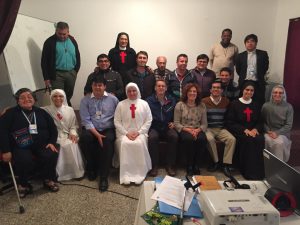 In Buenos Aires (Argentina), on 1-5 September, the providers of formation and the animators of vocations of the Camillian Pan-American world (Camillian religious, the Daughters of St. Camillus, the women Ministers of the Sick, the women Missionaries of the Sick Christ the Hope…) came together for their twentieth meeting of this ‘sector’. Their deliberations centred around a number of general questions: vocational discernment, the accompanying of candidates, the humanisation of relationships…Fr. Laurent Zoungrana, the Vicar General of the Order and the member of the General Consulta responsible for formation, also took part in the event.
In Buenos Aires (Argentina), on 1-5 September, the providers of formation and the animators of vocations of the Camillian Pan-American world (Camillian religious, the Daughters of St. Camillus, the women Ministers of the Sick, the women Missionaries of the Sick Christ the Hope…) came together for their twentieth meeting of this ‘sector’. Their deliberations centred around a number of general questions: vocational discernment, the accompanying of candidates, the humanisation of relationships…Fr. Laurent Zoungrana, the Vicar General of the Order and the member of the General Consulta responsible for formation, also took part in the event.
DECEASED RELIGIOUS
‘See, now they vanish, the faces and places, with the self which, as it could, loved them. To become renewed, transfigured, in another pattern’ (T.S. Eliot)
Father Giuseppe Facchin
1928-2016
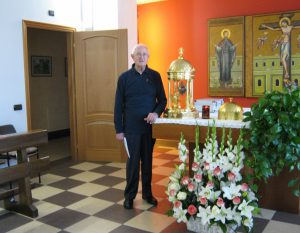 Giuseppe Facchin was born in Villaganzerla di Castegnero (VI) on 12.10.1928, the son of Giobattista and Erminia Bodinetti He was the last of eight children. In the town, his family was well liked by everyone for its simplicity, industriousness and its happy atmosphere of welcome. This was a ‘good terrain’ in which were born and grew the vocations of two of his sisters (they became Dorothean sisters) and his call to the Camillian life, to which Father Paolino Valdesolo also contributed. At the age of twelve, Giuseppe entered Villa Visconta (Besana Brianza) and then went on to the next usual stages: the novitiate in Verona San Giuliano (14.07.1946), his temporary profession (08.09.1947), and his perpetual profession (08.09.1950). His good will and intelligence suggested that he should be sent to the International College of Marino (Rome). He went to the Gregorian University, was awarded a licence in philosophy and theology, and was ordained a priest (17.03.56).
Giuseppe Facchin was born in Villaganzerla di Castegnero (VI) on 12.10.1928, the son of Giobattista and Erminia Bodinetti He was the last of eight children. In the town, his family was well liked by everyone for its simplicity, industriousness and its happy atmosphere of welcome. This was a ‘good terrain’ in which were born and grew the vocations of two of his sisters (they became Dorothean sisters) and his call to the Camillian life, to which Father Paolino Valdesolo also contributed. At the age of twelve, Giuseppe entered Villa Visconta (Besana Brianza) and then went on to the next usual stages: the novitiate in Verona San Giuliano (14.07.1946), his temporary profession (08.09.1947), and his perpetual profession (08.09.1950). His good will and intelligence suggested that he should be sent to the International College of Marino (Rome). He went to the Gregorian University, was awarded a licence in philosophy and theology, and was ordained a priest (17.03.56).
The first years of his ministry were spent in Verona San Giuliano as teacher and vice-teacher of the young religious (1957). After a short break involving studies in Rome, he was appointed master of novices (1964), a post to which he was often appointed during his priestly career. In the meantime, he was Provincial Councillor for Formation (1965), a member of the commission for the revision of the Constitutions of the Order (1967-68), and Superior and master of novices in Mottinello (1971) and then in Capriate (1974). During these years he was also an ad tempus parish priest at Crespi, where he won the esteem and affection of his parishioners.
The experience that he acquired in the fields of vocation and formation made him attentive and always ready to help during subsequent years when he was Superior at the St. Camillus Nursing Home in Milan (1980); Spiritual Father to the young religious in Verona San Giuliano (1983); chaplain at Villa Monga in Verona (1984); once again Provincial Councillor for Formation (1986); Superior and animator of vocations in Mottinello (1992); Superior at Verona San Giuliano (1998); Superior at Verona S. Maria del Paradiso (2004); Superior once again at Verona San Giuliano (2005); and then Superior at Mottinello (2007). Thereafter he went to and remained in Capriate, during which time he once again made himself available for the formation of novices. His health was still good, his ministry was tireless, his prayers forceful, but…the years were passing. Tiredness appeared and his doctors identified the first symptoms of a grave illness that was attacking his lungs. Father Giuseppe faced up with serenity to the treatment and care (which during the early years were successful) that was given to him by the medical doctors of the St. Pius X Nursing Home of Milan and by the religious of the community who looked after him.
Amongst the events that took place during the last years of his life, we love to remember the emotional and filial welcoming of the relic of the heart of St. Camillus on the occasion of the fiftieth anniversary of the creation of the nursing home (2014) and the celebration of the sixtieth anniversary of his priestly ordination (2016). On this last occasion, visibly moved, he said that ‘he was by now aware that he was drawing near to the completion of his journey, full of gratitude to the Lord for the years that he had spent in Camillian life and for the priesthood that he had received as a gift, trusting in the protection of Our Lady to whom he had always been filially devoted’. One could say that this was his spiritual testament.
When his malady had spread widely in his body, he was moved to the nursing home to join the other religious who were there. He always attended the afternoon Holy Mass and wanted to be a concelebrant. Two days before he died he asked for the sacrament of the anointing of the sick which he received with devotion. He died in the morning of 1 August 2016.
We are grateful to the Lord for the gift of this religious brother of ours and for so many of his fine features: his good, loyal and jovial character, open to friendship and fraternal communion; his example as a consecrated man and priest, always diligent in prayer and ministry; the human, spiritual and Camillian formation that he gave to novices with a fatherly heart and a young spirit; his warmth and enthusiasm in speaking about Jesus and the Order; his decorum during liturgical celebrations and Marian feast days; his readiness to help in response to requests for sermons, spiritual direction, and courses of spiritual exercises; his care and concern in providing help to the elderly and the sick in the nursing home; and his faith and serenity in suffering. Now from heaven may he continue to inspire us and encourage us on our journeys
Father Angelo Baglio
1931-2016
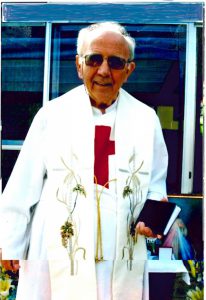 Angelo Baglio was born in Pontevecchio di Magenta (MI) on 11 March 1931 and was baptised the next day. His father Emmanuele and his mother Bianchi Rosa gave a human and religious upbringing to their nine children, two of whom followed the pathway of vocation to consecrated life: Sister Rosa, who was a member of the Daughters of Charity, and Father Angelo.
Angelo Baglio was born in Pontevecchio di Magenta (MI) on 11 March 1931 and was baptised the next day. His father Emmanuele and his mother Bianchi Rosa gave a human and religious upbringing to their nine children, two of whom followed the pathway of vocation to consecrated life: Sister Rosa, who was a member of the Daughters of Charity, and Father Angelo.
It was his own vice-parish priest, Don Virginio Colzani, who introduced him to the Camillians: ‘I have followed him since my first years as a newly-ordained priest and I immediately appreciated his delicate virtue, his deeply lived piety and the excellent example that he set…He has always displayed humility and commitment in his studies’.
Angelo began in S. Giuliano in Verona (26.08.1949) where he continued with his studies and his Camillian formation. In the space of a few days there took place his admission to the novitiate and then its commencement (07.09.1949). The next year, a holy year and the year of the proclamation of the dogma of the Assumption of the Virgin Mary, he made his temporary profession (08.09.1950). The young cleric Angelo then successfully completed his studies before his ordination as a priest at the hands of Bishop Msgr. Gerolamo Bortignon in Cittadella (22.06.1958).
The life of Father Angelo witnessed him – always with readiness to help and commitment – go through the various stages of provider of formation, student, chaplain and missionary. These were tasks he always performed with generosity and a sense of responsibility: teacher of the seminarians in Besana Brianza and at the same time a university student in classical humanities at the Catholic University of Milan (1958); Superior of the postulants in Marchirolo (1968) and in Varese; chaplain at the polyclinic of Pavia (1975); and then a missionary in Latin America (1977).
It was above all during these forty years that Father Angelo put to good work the fine qualities of his character and his spirit, as well as his capacities as an organiser, first in Colombia (1977) and then in Peru (1980). He worked as a chaplain at the Ospedale Materno Infantil; he was head of pastoral care for vocation, a councillor and the financial administrator of the Delegation of Colombia and Peru; the Superior and the financial administrator in Lima; a chaplain of the Arzobispo Loayza Hospital at the ‘Convento de la Buenamuerte’; a provider of formation for the novitiate of ‘San Martin de Porres’ and a chaplain at the ‘Istituto de Enfermedades’ of Lima; a provider of formation at the novitiate of Chaclacayo; the master of the novitiate of ‘Sant’Alberto de Chacrasana’; the financial administrator at the Casa di Trujillo; the parish priest of the Parish of the ‘Virgen de la Medalla Milagrosa’; and, lastly, once again, a provider of formation for the novitiate. His state of health forced him to return to Italy in 2012.
As one can observe, he engaged in intense activity in various fields of Camillian life, activity that was of extraordinary fecundity for the development of the Order in Latin America. Until the last months of his life in his conversations he did not conceal his satisfaction about the many years he had given to the Delegation and his hope that the future local generations would be able to receive the gift of the charism handed on to them and make it bear fruit with the same responsibility and spirit of sacrifice.
His dedication to prayer, his filial spirit in relation to Our Lady, the serenity of his heart and his smile, did not cease to fill his days even when his state of health was especially bad. After receiving the anointing of the sick with visible participation, and surrounded by his family relatives, he journeyed towards heaven on 10 August 2016.
It is almost our duty to finish with a fine anecdote. On the day of his perpetual profession of 8 December 1953, the beginning of the first Marian year, on a little picture to commemorate the event Father Angelo wrote: ‘To Mary…I offer the joy of my youth…From those whom this reaches I ask for the gift of a Hail Mary’. This is a request that is somewhat singular but which, however, communicates his quintessentially Marian spirit. Father Angelo will certainly be happy if we now give it to you as you read this, united with the usual prayers of suffrage.
‘Now they live in Christ whom they met in the Church, followed in our vocation, and served in the sick and the suffering. Trusting that the Lord, the Holy Virgin our Queen, St. Camillus, the Blessed Luigi Tezza, the Blessed Giuseppina Vannini, and our deceased religious brothers and sisters, will welcome them in their midst, we commend them in our prayers, remembering them with affection, esteem and gratitude’.
THE HOLY YEAR OF MERCY
PRAYER OF THE JUBILEE IN DIFFERENT LANGUAGES
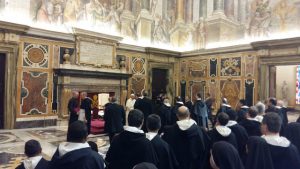 ‘This eighth centenary leads us to commemorate the men and women of faith, scholars, contemplatives, missionaries, martyrs and apostles of charity, who brought the kind gesture and the tenderness of God everywhere, enriching the Church and demonstrated new ways to incarnate the Gospel through preaching, witness and charity: the three pillars that guarantee the future of the Order and maintain the freshness of the founding charism.
‘This eighth centenary leads us to commemorate the men and women of faith, scholars, contemplatives, missionaries, martyrs and apostles of charity, who brought the kind gesture and the tenderness of God everywhere, enriching the Church and demonstrated new ways to incarnate the Gospel through preaching, witness and charity: the three pillars that guarantee the future of the Order and maintain the freshness of the founding charism.
God moved St Dominic to found an “Order of Preachers”, which has the mission of preaching that Jesus entrusted to the Apostles. It is the Word of God that burns within you and impels you to go forth to proclaim Jesus Christ to all peoples (cf. Mt 28:19-20). The Founding Father said: “First contemplate, then teach”. Evangelized by God, in order to evangelize. Without a strong union with Him, preaching might seem completely perfect, quite reasonable and even admirable, but it will not touch the heart, which is what has to change. The serious and assiduous study of theological matters is also essential, because it allows you to grow closer to reality and to listen to God’s people. The preacher contemplates the Word and also contemplates the people, who are waiting to be understood (cf. Evangelii Gaudium, 154).
Effectively transmitting the Word of God requires testimony: faithful teachers of the truth and courageous witnesses of the Gospel. Witnesses embody the teaching, they make it tangible, attractive, and leave no one indifferent; they unite the joy of the Gospel to the truth, the joy of knowing we are loved by God and are objects of his infinite mercy (cf. ibid., 142).
St Dominic told his followers: “Walking barefoot, let us go to preach”. He reminds us of the passage of the burning bush, when God said to Moses: “Put off your shoes from your feet, for the place on which you are standing is holy ground” (Ex 3:5). A good preacher is aware that he is moving on holy ground, because the Word he brings is holy, as are the people who are to receive it. The faithful not only need to receive the Word in its integrity, but they also need to experience the life witness of the preacher (cf.Evangelii Gaudium, 171). The Saints brought forth abundant fruit because, by their life and their mission, they spoke with the language of the heart, which knows no barriers and can be understood by everyone.
Lastly, those who preach and bear witness must do so in charity. Without this, they will be suspect and disputable. St Dominic had a dilemma at the beginning of his life, which marked the whole of his existence: “How can I study on dead skins while the flesh of Christ suffers?”. The body of Christ, alive and suffering, cries out to the preacher and does not leave him in peace. The cry of the poor and the excluded awakens us and helps us to understand the compassion Jesus felt for the people (Mt 15:32).
Looking around us, we find that the men and women of today are thirsting for God. They are the living flesh of Christ which cries out: “I thirst” for an authentic and liberating word, for a fraternal and kind gesture. This cry beckons us and must constitute the backbone of the mission and give life to structures and pastoral programmes. Think about this when you reflect on the need to adjust the structure of the Order, so as to discern the answer you must give to this cry from God. The more we go to satiate the thirst of our neighbour, the more we will be preachers of truth, of that truth proclaimed with love and mercy, which St Catherine of Siena speaks of (cf. The Book of Divine Doctrine, 35). In the encounter with the living flesh of Christ we are evangelized and we rediscover the passion of being preachers and witnesses of his love; we free ourselves from the dangerous temptation of Gnosticism, which is so prevalent today.
Pope Francis to those taking part in the General Chapter of the Order of Preachers (Dominicans), 4 August 2016.



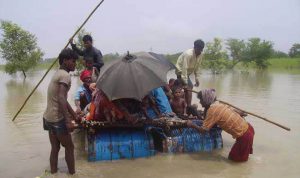

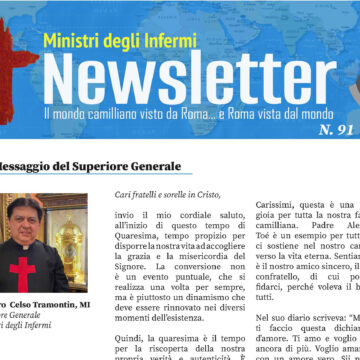










Camillians on Facebook
Camillians on Twitter
Camillians on Instagram